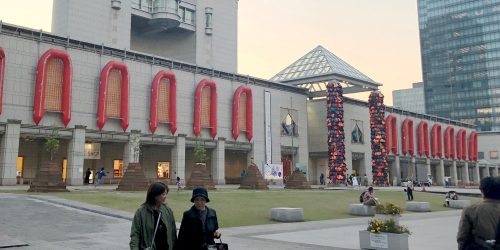だいちの星座によせて
松永真太郎[横浜美術館主任学芸員]
思えば四半世紀近くも前、ということになるが、私が美術大学に在学中、当時大学院に在籍していた鈴木浩之は絵画を描いていた。記憶が確かなら、気球船を思わせる楕円形の量塊が、抑制された色調で、大きなキャンヴァスいっぱいに描かれていた。重厚で理知的でありながら、むしろ柔らかさや詩情が立った画面だった。
それから10年あまり経たのち、とある展覧会を皮切りに鈴木の新しい作品に触れる機会が何度かあったが、そのとき彼の創作活動の主軸はメディアアート/インタラクティヴアートの領域にシフトしていた。技術やシステムへの拘泥が鑑賞者/参加者側の〈アクセス障害〉を招き、作品が〈機能不全〉に陥る、という事態はこの種のアートにつきものだが、鈴木のメディアアートはいずれもその罠を軽やかに回避していた。ゆらぐ光のヴィジョンをひとつの造形表現として成立させていて、そこに絵画のときと同じく、たしかな作者の体温を醸していた。
JAXAの大木真人との共同によるアートプログラム《だいちの星座》へとつながる創作活動が始動したのも、その頃だったようだ。人工衛星によって〈地上絵〉を描くというこの創作行為は鈴木のキャリアにおいて、その出自たる絵画の制作・技法研究と、以降のテクノロジーを介したヴィジョンの探究との結節点と理解できよう。子どもたち一人ひとりが〈星〉となり、小学校の校庭が〈星雲〉となり、ほかの星雲と結ばれてその土地オリジナルの〈星座〉をなす-。変則的なインタラクティヴ性を備えた参加型アートプログラム《だいちの星座》は、よく収斂された制作趣旨とプロセス、多数の人々の参加とテクノロジー介入の必然性、結果として写真に克明に刻まれる点の集積、そのあらゆる面で〈ヴィジョン〉の明快さが際立っている。そしてここにも、鈴木の作品らしい微温感と詩情とが息づいている。
一方で、その技術やプロセスの説明が主要素にならざるを得ない〈展示〉の局面において、それが成果発表展的様相を呈する危うさはある。ゆえに物理的に〈作品〉として提示される要素、すなわち人工衛星から撮像された一枚の写真をどのような形でプレゼンテーションするかは課題となろう。確かにこのプログラムは〈プロセス〉に重点を置くものであり、むしろその部分に本質があるだろう。だからこそ展示に際しても、最終成果物である写真作品とそれ以外とを明確に峻別し、制作趣旨および活用する技術の解説→制作過程を辿るドキュメント→結果として得られた図像、という組み立てにより、そのプロセスの追体験に鑑賞者をいざなう構成方法は考えられないだろうか。
さてその写真だが、電波を反射しないエリアが漆黒の闇として可視化され、そのなかで子どもたちが描きだした点の集積たちが線で結ばれることで、〈星座〉を擬している。星座における線は、言うまでもなく実在はしない。それは、数多の星からいくつかの点を抽出してなんらかの形象に見立てる際の、想像上の補助線である。では、あらかじめ点の布置が(学校の所在地に)定められている《だいちの星座》において、その写真のなかに引かれた線は、なにを意味するのだろう。
その線を、画面のなかの〈図〉と〈地〉とを切り分けるものと捉えてみるのはどうだろう。点が線で結ばれ図として立ち上がるとき、その周辺の広大な地の各所に息づくほかの点たちが、相対物として見えてくる。子どもたちが反射板で描き出した点が作為と刹那の表徴だとすれば、この地域に住む人々の営みの蓄積を示すであろう〈その他大勢〉は、無為であり痕跡である。漆黒のなかに散乱した、明るさも形状もまちまちなそれらの点たちは、ヴァルター・ベンヤミンの「砕け散った瓦礫」という言葉を思い起こさせる。
〈歴史〉という概念を〈星座〉に見立てたベンヤミンは遺作『パサージュ論』のなかで、「図像(イメージ)とは、これまでのものと今とが稲妻のごとく遭遇し、星座を成したものである」と述べている。《だいちの星座》は、多くの人の手とテクノロジーとを介した新たな視野の創出、という骨子を前面に押し出しつつ、それを基点として個々の地域の〈これまでと今〉に深くコミットしていくポテンシャルを無尽蔵に(文字どおり星の数だけ)孕んでいる。『パサージュ論』がパリという町をモチーフにした都市論であるように、作品自体が〈都市論〉あるいは〈土地論〉として自律的に展開していく可能性を、それは意味しているだろう。
松永真太郎
1972年生まれ。金沢美術工芸大学美術工芸研究科修了。島根県立美術館を経て、2003年より現職。専門領域は映像、写真、西洋近代絵画。主な展覧会企画に「斎藤義重展」(2003、島根県立美術館ほか)、「水の情景─モネ、大観から現代まで」(2007、横浜美術館)、「ロバート・キャパ/ゲルダ・タロー 二人の写真家」(2013、横浜美術館)、「石田尚志 渦まく光」(2015、横浜美術館ほか)など。
On the Occasion of Constellation of the Earth
Shintaro Matsunaga [Curator, Yokohama Museum of Art]
When I was in art university 20 years or so ago, I remember seeing a painting by Hiroshi Suzuki, who was enrolled in the school’s graduate program at the time. If memory serves, the picture, executed on a large canvas in subdued colors, depicted an elliptical mass that resembled an airship. The painting was profound and intellectual, but it was also rather soft and exuded a poetic air.
Ten years or so later, I had the opportunity to see Suzuki’s new works on numerous occasions beginning with a certain exhibition, but by that time he had shifted his focus to media and interactive art. Adhering to technology and systems often results in “access trouble” for the viewer / participant, causing the work to “malfunction,” but Suzuki’s media art easily avoided such pitfalls. As with his paintings, Suzuki synthesized flickering light into a single creative expression, and conveyed the artist’s warmth.
It was right around this time that he began working on something that would lead to Constellation of the Earth, an art program he developed with Masato Ohki of JAXA (Japan Aerospace Exploration Agency). In Suzuki’s career, the use of satellites to make these “geoglyphs” can be seen as the node between his original production and technical study of painting, and his later exploration of a technology-mediated vision. Each child became a “star” and the elementary school playground a “galaxy,” which, by joining with other galaxies, formed a “constellation” that was unique to that area. Constellation of the Earth is a participatory project imbued with an anomalous interactive quality. The clarity of its vision is remarkable in many respects, including the well-integrated artistic objective and process, the necessity for widespread participation and technological intervention, and the resulting collection of dots scrupulously imprinted on photographs. Here again, one senses the warmth and poetry that is typical of Suzuki’s work.
On the other hand, when it comes to displaying this type of work, which necessarily requires an explanation of the technique and process, there is a danger that it will simply turn into a results briefing. This raises the question of how to effectively present the essential elements of the project as a physical work – i.e., the satellite photographs. The program places a strong emphasis on process, and this is perhaps where its essence lies. Does that rule out a structure that invites the viewer to relive the process? One that is organized by clearly distinguishing between the final products (photographs) and the remaining parts – and sequentially detailing the objective and technique, documenting the production process, and displaying the resulting images?
In these photographs, the areas that do not reflect radio waves are visualized as pitch-black darkness, and the collections of dots that the children drew within these spaces are connected with lines to form constellations. Needless to say, these lines do not actually exist. They are imaginary additions used in selecting several dots from countless stars and likening them to some kind of shape. That being the case, what sort of meaning do these lines have in a work in which the arrangement of dots has already been fixed (according to the location of the school)?
What happens if we try to see the lines as separate entities like the figure and ground in a painting? When dots are connected with lines to make a picture, the other dots, which dwell everywhere in the surrounding expanse, become counterparts. If the dots that the children draw on the reflective plates are symbols of the intention and the moment, the huge number of remaining dots, indicating the activities of others in the area, suggests idleness or vestiges of activity. Scattered across the blackness and varying in brightness and shape, these dots call to mind Walter Benjamin’s phrase, “catastrophic ruins.”
Comparing the concept of history to a constellation in The Arcades Project, Benjamin argued that an image is a constellation that emerges when the past encounters the present like a flash of lightning. While asserting that Constellation of the Earth has evolved a new field of vision with the help of many people and technology, I would also like to point out that the work contains a vast potential (literally as vast as the number of stars in the sky) with a deep commitment to the past and present of the areas that were involved in the project. Just as The Arcades Project was an urban theory of Paris, Constellation of the Earth’s significance is rooted in the fact that it has the potential to develop autonomously as a theory of the city or area.
Shintaro Matsunaga
Born in 1972. Completed a master’s course at the Kanazawa College of Art. After a stint at Shimane Art Museum, Matsunaga transferred to the Yokohama Museum of Art in 2003. His areas of specialty include the moving image, photography, and modern Western painting. Among the numerous exhibitions he has curated are The Retrospective Exhibition of Saito Yoshishige (Shimane Art Museum et al., 2003), Views of Water: From Monet, Taikan to the Present (Yokohama Museum of Art, 2007), Two Photographers: Robert Capa Centennial / Gerda Taro Retrospective (Yokohama Museum of Art, 2013), and Billowing Light: ISHIDA Takashi (Yokohama Museum of Art et al., 2015).

No responses yet